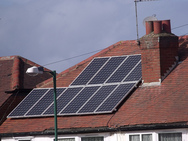Preservation staff reject solar panels on Cleveland Park home

Photo by ell brown on Flickr.
If you own a home in a historic district in DC, you can’t install solar panels, unless nobody can see them from a street. That’s the recommendation from historic preservation staff on a case the board will debate today.
A homeowner on Newark Street in Cleveland Park wants to add solar panels to the roof. The house faces south, meaning that the only side invisible from the street would be the north side which gets far less sun.
The Cleveland Park Historical Society supports the panels. From their website:
CPHS’s Architectural Review Committee supports the installation of solar panels on this property, not on the street-facing slope of the roof (which the applicants do not propose), but on more of the west face of the roof than was originally proposed, in order to regularize the array of panels. The ARC is interested in encouraging the use of alternative energy sources in the historic district. It received very strong statements of support from neighbors adjoining the property.
However, the staff report says that according to current preservation guidelines, solar panels are okay but only if nobody can see them from a street. If they can, no solar panels.
In fairness to historic preservation staff, they seem to be trying to follow their written guidelines. Preservation decisions are already so subjective, and the more preservationists can make them predictable, the better.
However, these guidelines are still very vague and leave lots of room for staff or the board to come out differently on similar cases. For example, staff recommended against letting the building replacing the Christian Science church at 16th and I have a penthouse level with occupiable space, and most board members agreed. But, ANC members pointed out, in 2007 staff supported a penthouse roof terrace for the Hay-Adams hotel, right on Lafayette Park.
Listen to any meeting of the Historic Preservation Review Board, the appointed body that makes the ultimate decisions, and few members on either side of the issue talk about how a case fits with similar cases elsewhere or how a project lines up against guidelines; instead, you hear a lot of very personal opinions about whether members “like it” or not.
A bigger problem is the one Matt Yglesias pointed out: The preservation process narrowly excludes every single factor except for historic “compatibility.” In most public decisions, officials weigh a variety of factors against one another. Here, the board must ignore the value of environmental sustainability, the economic impact, and even the owner’s hardship or religious freedom.
At the previous HPRB meeting, where the board landmarked the 1960s urban-renewal Tiber Island project in Southwest, preservation chief David Maloney noted that there was “not yet public support” for a wider historic district in the neighborhood. As long as the preservation process holds that “compatibility” is the sole factor and overly restrictive guidelines define it so narrowly, it’s unlikely there will ever be public support for another historic district.
Anyone who’d rather see no more preservation at all would probably appreciate this conclusion. So, perhaps, do those who only care about blocking development in a select few already-designed neighborhoods and who care little about the rest. Everyone else, however, ought to hope our preservation process can reach a better balance in keeping with the broader priorities and needs of the city.
Update: The Montgomery County Historic Preservation Office followed up with a tweet about how in their county, they’re okay with visible solar panels when done tastefully and when it’s the only option. A store in Glen Echo Heights got permission to add the panels. DC would do well to follow suit.
Update 2: The board voted 4-3 today to reject the solar panels. In an initial vote, members Andrew Aurbach, Maria Casarella, Graham Davidson and chair Catherine Buell voted to allow the solar panels, while Rauzia Ally, Nancy Metzger, Gretchen Pfaehler and Joseph Taylor voted no. Buell then abstained in a subsequent vote to allow the board to pass a motion.
